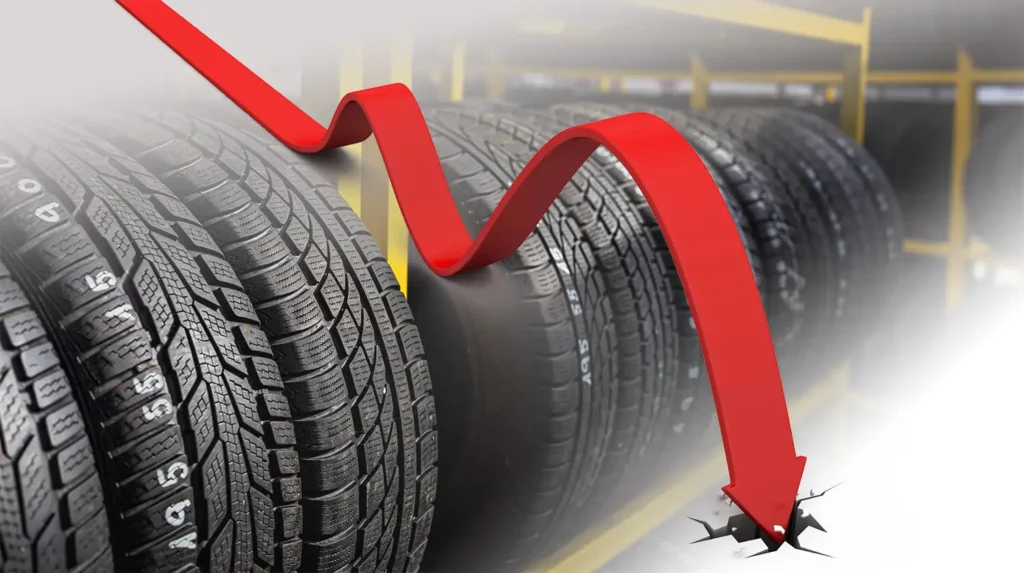Tire theft at car dealerships is an expensive problem that affects the bottom line and can disrupt operations. This type of crime targets all car dealerships and tire shops that store volumes of tires. They tend to be stored in accessible outdoor lots or less-secured storage areas, which makes them an easy target for theft.
Why are tires a hot item to steal? They have a high resale value, they’re effortless to transport, and they’re low risk with high reward. Crooks go after tires because they can often break through weaker security measures such as poor lighting, insufficient surveillance systems, and limited physical barriers.
Moreover, the universal demand for tires in the market makes them simple to sell, compounding the problem for dealerships and tire shops. The impact of tire theft extends beyond inventory loss. Tire theft affects insurance premiums, customer satisfaction, and the dealership’s reputation.
How Serious Is Tire Theft?

These are just some of the stories that pop up when you do a quick search. Car, parts, and tire theft is an expensive and potentially dangerous problem. CBS Austin reports a car dealership in the small town of Fredericksburg, Texas, that had a high-volume theft of their tires and rims.
Corpus Christi police ask for help with a scam affecting dealers who sell tires. The scammers are buying tires with a stolen credit card and sending a third party to pick up the tires. Corpus Christi police advise dealerships and tire sellers to be wary of anyone buying a lot of tires and to confirm the credit card has not been stolen. These calls tend to come from the Spring or Houston area.
Not surprisingly, the police believe that some dealers have not reported being scammed. Many crimes tend to go unreported out of embarrassment, fear of rising insurance premiums, and protecting their reputation.
Plano Police tell The Dallas Express that vehicle crimes are increasing and thieves are more dangerous. In describing the suspects, police used the terms bold and violent. They urge people to avoid trying to stop the crime. One citizen attempted to confront the suspects with his gun and the citizen got shot four times. The survivor is paralyzed from the knees down.
WMAR-2 News in Baltimore reports on crooks stealing everything including tires. The story says there were only 15 reports of tire theft in 2022. That number jumped three times to 45 reports. Another reason criminals focus on tires is that they’re harder to track down. It affirms the cost of tire theft is more than the price of replacing the tires. One victim had to pay a deductible.
The Auto Wire story opens with “This is pretty brazen.” It’s evidence that crooks are bolder about committing auto-related crimes and they’re going after dealerships. One dealership had four tires stolen off an Escalade at the front of the dealership. Police in Amherst, NY, arrested suspects for their connection to stolen tires and wheels from a dealership according to 2WGRZ News.
The problem is so bad that a dealership in Englewood, Colorado, tells Fox31 they’re offering a reward. They had tires, wheels, and broken parts worth tens of thousands of dollars stolen. One vehicle had damage that cost $10,000. While the dealership had video surveillance, they weren’t high definition, and they have since upgraded their cameras. It shows that there’s a difference between proactive and reactive video surveillance.
FOX 43 tells the story of a man who had a U-Haul box truck parked by a dealership. The truck had more than 30 tires taken from the dealership in Lancaster County, Pennsylvania.
How Can Dealerships Deter Tire Theft?

To overcome these challenges, dealerships turn to rigorous inventory management practices and policies, staff training on those policies, and integrated security solutions.
Use an inventory management system
Effective inventory management is an important tool for deterring tire theft at dealerships. By keeping precise track of parts and tire stock using automated systems and stringent policies, dealerships can reduce the risk of theft and quickly find discrepancies that may reveal a security breach.
Modern Tire Dealer explains how employees steal tires from a dealership. Yes, internal theft is a problem. An employee in the dealership’s service center works on replacing tires on a vehicle. They go in the back to get the tires and bring them out. They turn out to be the wrong tires. The employee goes back to get the correct set of tires.
Meanwhile, the wrong tires are still sitting in the service center along with the four replaced tires. The employee will head back to the dealership service center and swipe the four new tires to sell them.
Dealerships can help keep this from happening by doing a dead count. This is an easy process worth performing. A dead count involves checking the point-of-sale system for the tire count and then counting the tires. Another option is to use locking lugs that come with a key. This adds a barrier to deterring theft. When thieves discover the locking lugs, they will typically move on. These cost between $20 and $40, far less than the cost of tire theft.
Implementing an automated tracking system is fundamental and a standard practice. They track and account for all parts, tires, and vehicles. Such systems use barcodes or RFID tags to monitor each tire’s movement in and out of the storage area. This technology streamlines inventory processes and creates an audit trail that can help identify patterns or anomalies.
Conducting regular audits helps maintain the integrity of the inventory management system. Scheduled and surprise audits help ensure the physical tire count matches the documented inventory. These audits can expose inconsistencies and prompt an investigation into potential theft or security gaps.
Document processes and procedures
Modern Tire Dealer recommends using tickets. Every vehicle must have a ticket. All parts deliveries must come with a purchase order. And finally, all tires and parts must be returned on the spot. Employees should do visual inspections and document all parts including tire make and model, filters, and so on.
Limiting access to tire storage areas to authorized personnel only is another effective strategy. By using key cards or biometric systems, dealerships can control who accesses the tires and track entry and exit times, making it easier to identify potential internal theft.
It’s possible to link inventory management systems with security systems such as security cameras to add layers of protection. For instance, activating cameras based on inventory system alerts can capture unauthorized access or suspicious activities around tire storage areas.
These are all procedures for handling and tracking inventory. Therefore, the dealership needs to document policies and processes. Then, employees need training in these procedures to ensure everyone understands how to manage and secure the inventory properly. Training is not a one-time deal. Employees must undergo regular training updates to stay on top of security practices.
Integrate security solutions

Integrated security solutions come with multiple layers of security to enhance the safety and security of the dealership to protect its valuable assets. These solutions combine various technologies and strategies to create a comprehensive security system that can help detect, deter, and document theft incidents.
Some dealerships had video footage of the theft. But they were grainy, making it hard to obtain useful information. Thus, an integrated security system needs high-definition surveillance cameras. Video cameras should be posted throughout the dealership including the perimeter, lot, and interiors, especially tire storage areas, entry points, and other sensitive zones.
Modern cameras equipped with night vision, motion detection, and remote monitoring capabilities provide round-the-clock surveillance and can be accessed from any location, ensuring continuous oversight. Some of the news stories did not mention monitoring services. This is the one differentiator between proactive and reactive video surveillance. Without monitoring, it’s hard to catch a crime before or as it happens.
Integrate alarm systems by installing them on doors, gates, and tire storage cages. They add another lever to alert someone that a potential crime may be in progress. These systems equipped with artificial intelligence can differentiate between routine operations and potential security breaches to reduce false alarms and speed response.
An access control system integrated into security helps control who can access the tires. Authorized personnel can use keycards, fobs, or biometric data to get into limited-access areas where high-value items are stored. These systems can log entry and exit times, providing valuable data for audits and investigations.
Something some security vendors don’t think about is updating and maintaining security technology. Look for security companies that conduct regular updates to help protect against hacking and cyber threats. Routine maintenance also helps prevent failures that could lead to security breaches.
Integrated security solutions can provide a robust framework to protect dealerships from tire theft. By combining advanced technology like video surveillance with remote monitoring and strict management protocols, dealerships can bolster their defense against crime to safeguard their assets and preserve business continuity.
Stop Auto and Tire Theft in Its Tracks

Adopting inventory management systems, policies and procedures, and integrated security solutions at auto dealerships can strengthen inventory management and dealership operations. These solutions help secure tires, vehicles, and parts while following dealership best practices.
Implementing these three strategies helps dealerships stay competitive in a challenging market. They can cut risks, improve operational adeptness, and boost customer service. The strategic implementation of these strategies shows the dealership prioritizes security and operational excellence.
For more insights on dealership security and deterring theft, check out auto dealership theft trends. Please contact us with any questions.

